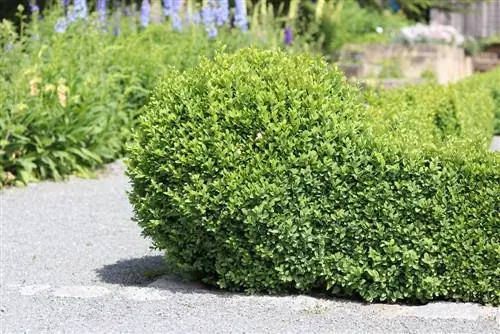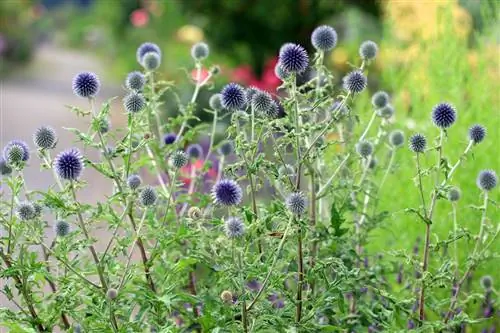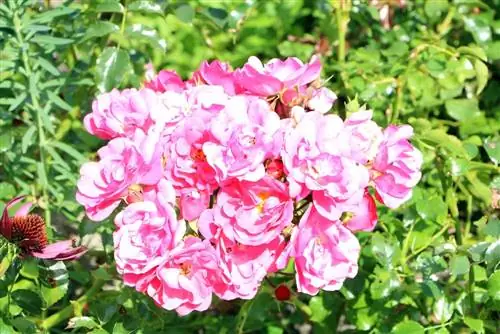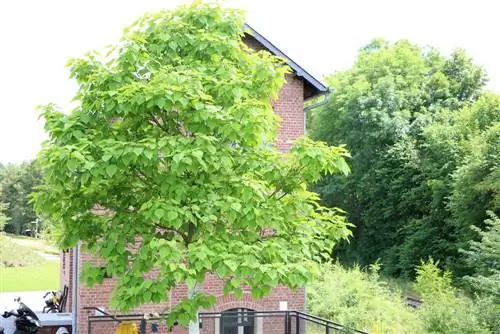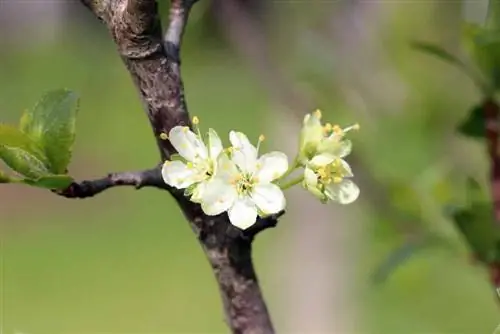- Author admin [email protected].
- Public 2023-12-17 03:39.
- Last modified 2025-01-24 12:45.
As an evergreen plant, the Bux tree is one of the most popular types of (hedge) shrubs and trees in Germany's gardens. When cultivated in pots, it creates a decorative ambience on balconies and terraces. It is versatile, but can quickly become sensitive if not cared for properly. For he althy, long-lasting growth, some important rules summarized by experts should be followed.
Profile
- Botanical name: Buxus
- Common names: Buxbaum, Boxbaum
- Plant genus: boxwoods
- Plant family: Boxwood family (Buxaceae)
- Distribution: Southwest and Central Europe, is also in North Africa and West Asia
- Growth height: as a tree up to eight meters
- Flowering time: between April and June (only older plants)
- Flower color: yellowish-white
- Lime compatibility: very good
- Location: partially shaded or sunny without direct sunlight
- Poisonous: Yes
Location
When planting for the first time, pay attention to an optimal location, which has a decisive influence on growth and lifespan.
The location for boxwoods should meet the following requirements:
- Warm and bright without direct midday sun
- Tolerates partial shade (if it is too dark, the risk of fungal infection increases)
- East or west orientation with morning and/or evening sun is optimal
- Protected from the wind
Change location
The Buxus doesn't like moving or transplanting because it has difficulty getting used to a new environment. If transplanting or moving is still necessary, care should be taken when changing location to ensure that the conditions are approximately the same as at the original location. The more similar the light and soil conditions are, the better the boxwood plant can cope with a change of location.
Soil texture
For a good supply of nutrients and a secure fit in the soil, it must meet certain conditions:
- Clay or sandy
- Not too wet/not too dry
- Water permeable
- Loose
- Nutrient Rich
- Calcareous
- pH value: between 7 and 8
Plant substrate
If the Bux tree is cultivated in a pot, it is advisable to use a high-quality substrate instead of conventional potting soil. This should have the following properties:
- Loose, ideally enriched with perlite
- Water permeable
- Humus-rich
- Calcareous
- With clay or sand
- Cactus soil offers an alternative
Best planting/potting time
When a boxwood should be planted or potted depends on how the roots are “packaged”:
- Bux trees grown in pots or containers: all year round outside of frost periods
- With root balls: from October to May
- Exposed roots: between October and November and February to April
Tip:
For trouble-free growth and a quick start to growth the following year, October is best for planting. Here the sun usually still provides warmth, which makes it easier for the boxwood to “settle in”.
Repotting time
Repotting the Buxus is usually only necessary if the pot has become too small for the amount of roots. With he althy growth, this happens every two to three years. The best time here is in April.
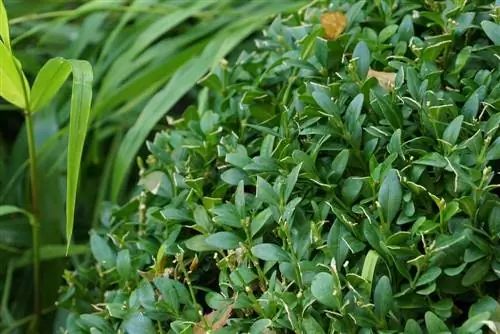
If repotting is necessary due to an illness that requires changing the substrate, then repotting should be done at any time. In the event of frost, repotting may need to take place in a warmer place and the plant must then be placed frost-free during the frosty months. However, this is only recommended in an absolute emergency because every change of location places additional stress on a diseased bux tree.
Planting/Potting
When planting and potting, be careful as the boxwood family has sensitive roots. The following instructions describe step by step how you should proceed:
Planting
- Soak the root in a bucket of water for several hours
- Dig out a planting hole that is around 15 to 20 centimeters larger than the root ball
- Lay the planting soil two centimeters high with quartz sand or gravel (drainage prevents waterlogging)
- Place approximately eight centimeters of soil enriched with humus on the drainage
Insert boxwood in the middle
- For root balls, the ball cloth is only opened after planting, but not removed
- For bare roots, remove previously damaged, bent roots and shorten the rest to around 25 centimeters
- Enrich the remaining excavated soil with compost and fill it into the planting hole
- Root neck must be covered with soil 5 centimeters high
- Tamp down the soil and water well
Planting spacing
- Number of plants per square meter: seven to nine
- Planting distance: at least 35 centimeters depending on the height of the plant
- Planting distance for desired hedge growth: between 20 centimeters and 25 centimeters
Stew
- Choose a bucket with a drainage hole so that excess water can escape
- Line the bottom of the bucket two centimeters high with quartz sand, gravel or pottery shards (prevents waterlogging)
- Fill a third of the bucket with substrate
- Insert Bux tree in the middle
- Refill substrate and press firmly
- Substrate distance to the edge of the pot: approximately two centimeters
- Pour moderately
- After two days, check whether the substrate has settled and refill if necessary
Tip:
Place a saucer under the bucket/pot, excess water can run in and will not cause unsightly water stains on patio or balcony floor coverings. However, the water should be removed promptly so that no waterlogging occurs.
Pouring
Basically, a Buxus should never be too moist, but also never too dry, although it copes better with short-term dryness than with permanent moisture. Hot summer temperatures increase water needs and may require daily watering. In spring and autumn, rain usually covers the lower water requirements.
In winter the Buxus is undemanding and watering is less necessary even when kept indoors. The moisture level should still be checked regularly to prevent the soil/substrate from drying out.
It is important that there is no waterlogging. The Buxbaum reacts sensitively to this. This makes him more susceptible to disease.
Tip:
You should only water boxwoods directly on the ground and avoid leaf contact with irrigation water. This increases the risk of fungal infection. The optimal time to water is in the morning so that any wet leaves can be dried quickly by the sun.
Fertilize
The boxwood is quite undemanding when it comes to its nutrient requirements. However, it still needs small doses of fertilizer every now and then to support he althy, strong growth. The fertilizer recommendations are as follows:
- Start of fertilization: mid-April
- Fertilization rhythm: every four weeks
- Fertilization end: end of July
- Additional fertilization for outdoor overwintering: In September with special potassium fertilizer with high magnesium and sulfur content
- Fertilizer: Liquid fertilizer especially for Bux trees, which is administered with the irrigation water
Cutting
In principle, boxwoods do not need to be cut. A cut is necessary if a certain size or shape is to be maintained. Whether as a hedge, standard tree or well-formed ornamental shrub, regular trimming is necessary in these cases. He althy, vigorous specimens need to be cut twice a year. If you insist on perfectly straight lines, you may have to use scissors every four weeks to bring newly formed and protruding leaves and shoots back into height.
It should be taken into account that every cut places a strain on the buxus and increases the risk of infection. For these reasons, it is advisable to avoid frequent cutting and limit yourself to a maximum of twice a year.
You should know the following about pruning boxwood trees:
- A rough cut is carried out at the beginning of May before growth begins
- Fine pruning takes place after the summer shoots in July/August
- Best time to prune on dry, sunny days
- Only use sharp cutting tools, otherwise it can cause bruising
- Cut off old and dried shoots
- Cutting is always done from top to bottom
- From the end of August you should no longer cut
Exception: standard boxwood
If the boxwood is grown as a standard tree, more frequent cutting of the side shoots on the trunk will be necessary. It is beneficial for crown growth if newly emerging side shoots on the trunk are quickly cut off. Not only do they disrupt the well-groomed overall appearance, but they also “robb” the foliage of too many nutrients that it needs for strong, dense growth. This is why the following applies to standard Bux trees: always cut away side shoots on the trunk directly! But here too it will be over by the end of August at the latest because the boxwood standard trunk also has to prepare for the winter.
Wintering
Most boxwood varieties are hardy and can spend the cold season outdoors if some precautions are taken. Above all, the location or the location requirements of the individual varieties determine whether frost damage is to be expected. The most common common boxwood (Buxus Sempervirens), for example, cannot tolerate full sun and icy drafts in winter. Sun-lovers like the “Blue Heinz”, on the other hand, tolerate cold winter breezes and do well in a sunny location. Basically, it should be noted that hardy boxwoods do not have to expect life-threatening frost damage in the worst case.
Container overwintering
Specimens cultivated in a pot are significantly more sensitive than the planted boxwood. Especially when standing on the terrace, the ground frost penetrates directly into the roots. Icy winds additionally cool the substrate. The roots are therefore at the mercy of the winter cold. Therefore, precautions must be taken here to ensure that the potted bux tree survives the winter well:
- Lay an insulating layer of polystyrene, wood or thick cardboard between the substrate and the bottom of the bucket
- Be sure to place the potted plant on the wall of the house or against a dense hedge, protected from the wind
- Under no circumstances water when it is frosty
- Do not remove frozen plant parts - be sure to wait until next spring
- In extreme sub-zero temperatures, cover the bucket with jute - cover the Buxus with a plant fleece
- Cover substrate surface with straw, brushwood or leaves
Frost-free wintering
If the Buxbaum is to spend the winter indoors at room temperature, the following must be taken into account during the winter rest:
- Put in before the first frost
- Partially shaded location is optimal
- Cool temperatures between 15 degrees Celsius and 20 degrees Celsius are optimal
- It is essential to avoid cold drafts and dry heating air
- Water little, do not cut or fertilize
- It can be put outside again from April
Propagation
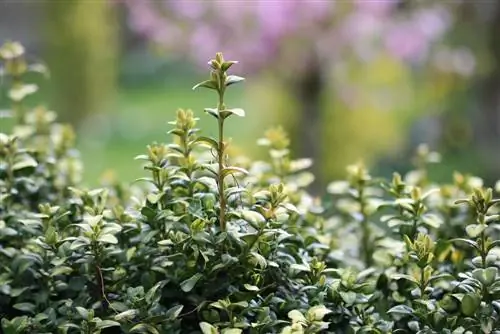
The Buxus is easy to propagate through cuttings. Sowing is not recommended because it is lengthy and difficult.
When propagating cuttings, you should stick to the following details:
- Best time for propagation: mid and late summer
- Take fresh shoots from the mother plant that are at least ten centimeters long
- Cut off at least five centimeters of the lower bark strips and the lower leaves except for three pairs of leaves
- Short the shoot tip by a third
- Fill the planting hole or growing box with potting soil and press the cutting into it
- Location for outdoor propagation: shady and protected from the wind
- Location of the propagation box/pot: partially shaded, no dry heating air, prefers morning or evening sun
- Water moderately after plugging in the soil
- Put translucent film over the cutting
- Open the film every two days to ventilate and moisten the soil
- Remove the film when the first new leaves form
- Then transplant from the propagation box into normal substrate or garden soil
Tip:
Cuttings should not be cut from the mother plant for propagation, but rather torn off.
Diseases
Old boxwood varieties are significantly more susceptible to diseases than the newer varieties. But fungi in particular can cause problems for boxwood trees. If they are too crowded or kept too moist, a fungal disease will be provoked. But fungal diseases are usually easy to get under control. A generous pruning and of course optimal care including a suitable choice of location is usually enough.
Typical illnesses include:
Boxwood crab (Volutelle buxi)
The boxwood cancer usually only affects individual plants. There is no spread to neighboring plants.
The disease can be recognized by:
- Formation of yellow to green spots
- Dried leaves and increased leaf litter
- Pink spores on the undersides of the leaves
- Cracks on the bark
Combat
A generous cutting out of affected parts of the plant usually helps. If the infestation is severe, a fungicide can be used. During subsequent care, you should avoid cutting or moving/replanting in the following six months in order not to expose the Buxus to additional stress.
Box wilt (Fusarium buxicola)
This fungal pathogen predominantly attacks weakened bux trees. It spreads mainly on the leaves and shoots. These take on a leathery appearance, turn brown and dry out. Dark brown, dot-shaped spore coatings expand.
Combat
Here it is important that the disease is treated quickly before the plant damage becomes too extensive and/or the pathogen spreads to neighboring plants. Consistent pruning is the most effective method of combating the fungus. If the affected bux tree has recovered well, it should be shortened by a third overall. In this way it becomes more robust and resistant to box wilt.
Boxwood rust (Puccinia buxi)
The Puccinia buxi fungus mainly affects Buxus sempervirens in older age or as a weakened plant. The disease manifests itself primarily as follows:
- Brownish, arched hump formation of the leaves
- White spots form on the undersides of the leaves
- Approximately two millimeters large rust pustules on both leaf sides
Combat
Cutting out large areas of affected plant parts is usually not enough here. In addition, it is recommended to use a fungal agent (fungicide) to completely kill the fungus.
Pests
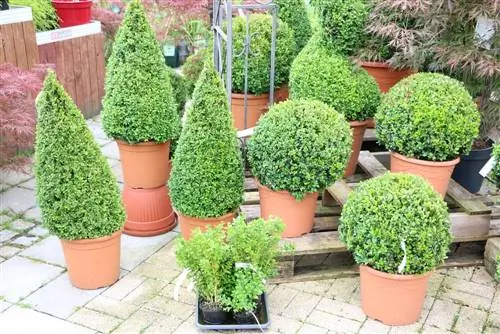
Box trees are not only popular with plant lovers, but pests also enjoy the decorative plants. Above all the boxwood moth.
Boxwood moth
Signs of a boxwood borer can be:
- Eaten leaves
- Formation of webs, usually inside plants
- Spread of green-black caterpillars, mainly on the leaves
Combat
The boxwood borer is quite easy to combat using environmentally friendly methods, so you don't have to use toxic products.
High-pressure cleaner
- If you spray your bux tree from top to bottom with a high-pressure cleaner, the caterpillars will fall down
- Place a foil under the bush/tree so that the falling caterpillars can be picked up better
- Always tip at an angle away from the foil so that the caterpillars are not washed off the foil
- Then dispose of the film and the caterpillars in the household waste and continue care as usual
Neem treatment
Neem spray and powder products for mixing in water are available from specialist retailers. This is a biological, environmentally friendly agent that causes suffocation in the boxwood borer's respiratory organs by sticking them together.

